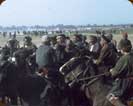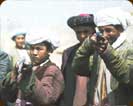 The Music Culture
Some of the musics I heard and saw were shared by many or all groups, while others stayed within "ethnic boundaries," a term coined by Frederik Barth in 1969. He had noticed that populations identified by themselves or outsiders as an "ethnic group" would keep some culture to themselves, while also participating in the general life of a multiethnic society. The boundaries could be flexible and changeable. Music was certainly like that. But beyond ethnic boundaries lie more general attitudes to music as a human activity, beliefs that come from religious and aesthetic tenets that run deep.
In northern Afghanistan, and countrywide, Islamic thought dominates. Everyone is Muslim (outside a handful of Jews and some Hindus, mostly in Kabul). Although Islamic sources and societies have interpreted the value of music differently over the centuries, local and high-ranking clerics and some rulers have had a bias against any type of sensually-arousing entertainment. Many categories are not even thought of as "music" in the western sense, since the local languages have no word like English "music" (French musique, German musik) to embrace the full range of humanly organized sounds, from religious chant to lullabies.
The most common term associated with musical activity is showq, or showqi, which a standard Persian dictionary defines as "filling with desire; desire, yearning, love; affection, inclination, predilection; fancy, pleasure; curiosity, sympathy." This is a very broad range of emotional response and sensibility. Activities called showqi range from animal fights, lavish decoration of everyday objects, making collections of things, to gambling and involvement with music as a passionate listener or a player. All of these are "enlivening," but socially dangerous, in that they might lead to improper or immoral behavior. An American counterpart might be the distinction between being a gun collector, gun buff, or a gun "nut" along a continuum that leads from innocence to obsession or possible criminality.
Filmclips show some of these activities. Many involve animals, for contests or fights. Buzkashi, the national sport, has an unlimited number of competitive riders (chapandoz) riding exquisitely bred and trained horses. The object is to seize a heavy stuffed animal carcass (often a goat) with one hand and fend off your rivals while dodging and weaving around a specified route to drop it in the winnerís circle. Special whips make this a very hazardous sport. By contrast, kowk-bazi makes partridges into fighters. Released from their special cages and carefully bred, these small birds go at each other under the watchful eye of referees. When it becomes clear which partridge is "chicken," the match ends, since as in most of these animal fights (which range up to dogs and camels), the prized creatures are too valuable to have injured or killed. A mesmerized betting circle of men stands around at 5 am before a long working day at the old fortress in Tashqurghan.
Some of what we call music, then, might be legitimate and normal, while other sides of musicality would be suspect or actually outlawed. The extreme of that latter position came during the reign of the Taliban (1996-2001), who imposed a severe puritanical regime, outlawing almost any form of "music" and heavily penalizing violators. John Baily summarized this period in a fine report (www.freemuse.org). But recent reports, also from Baily show that even under the fierce Taliban repression, women were allowed to play the doira (a tambourine-like drum) and sing for weddings. This fact points to the way music divides along lines of gender, and there are music divisions according to other status categories. Some musicians inherit their craft from their families, while others come to music from other fields. One of the musicians I worked with most was Bangecha Tashqurghani, who said "everyone knows my qowm are musicians." Another key collaborator, Aq Pishak, started as a simple shepherd and only slowly developed into a professional performer. Even among professionals, there is a sharp line between qespi barber-musicians, a hereditary trade, and the more respected masters of "high-class" music in Kabul, the capital.
Then there are the amateur showqis, like the enthusiastic, private middle-class players in the larger cities. They are far removed from other non-professional musicians, the nomads and shepherds who pass long hours in remote places by playing the flute. This subtle set of categorizations suggests a fairly complex, but well understood social organization of music. Another way to look at things is by who gets paid for performing, regardless of their enthusiasm. The merchant who enjoys making music for a circle of friends is worlds apart from the struggling public player, who ekes out a living at teahouses and celebrations. The few women who make their living as musicians, whether provincially as wedding entertainers or as radio divas, can expect a great deal of disrespect if they take money, as opposed to family members picking up the drum and singing for a wedding. Finally, a separate category includes the malang or darwish, street musicians who accept contributions but who sing only sacred songs. Somewhat related are the various healers, using Islamic or pre-Islamic incantations, who help people get better through staged performances. These last groupings are not, of course, considered "music" in any sense that would include entertainment.
|












